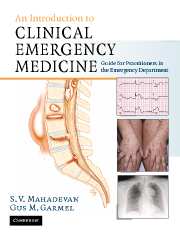Book contents
- Frontmatter
- Contents
- List of contributors
- Foreword
- Acknowledgments
- Dedication
- Section 1 Principles of Emergency Medicine
- Section 2 Primary Complaints
- 9 Abdominal pain
- 10 Abnormal behavior
- 11 Allergic reactions and anaphylactic syndromes
- 12 Altered mental status
- 13 Chest pain
- 14 Constipation
- 15 Crying and irritability
- 16 Diabetes-related emergencies
- 17 Diarrhea
- 18 Dizziness and vertigo
- 19 Ear pain, nosebleed and throat pain (ENT)
- 20 Extremity trauma
- 21 Eye pain, redness and visual loss
- 22 Fever in adults
- 23 Fever in children
- 24 Gastrointestinal bleeding
- 25 Headache
- 26 Hypertensive urgencies and emergencies
- 27 Joint pain
- 28 Low back pain
- 29 Pelvic pain
- 30 Rash
- 31 Scrotal pain
- 32 Seizures
- 33 Shortness of breath in adults
- 34 Shortness of breath in children
- 35 Syncope
- 36 Toxicologic emergencies
- 37 Urinary-related complaints
- 38 Vaginal bleeding
- 39 Vomiting
- 40 Weakness
- Section 3 Unique Issues in Emergency Medicine
- Section 4 Appendices
- Index
19 - Ear pain, nosebleed and throat pain (ENT)
Published online by Cambridge University Press: 27 October 2009
- Frontmatter
- Contents
- List of contributors
- Foreword
- Acknowledgments
- Dedication
- Section 1 Principles of Emergency Medicine
- Section 2 Primary Complaints
- 9 Abdominal pain
- 10 Abnormal behavior
- 11 Allergic reactions and anaphylactic syndromes
- 12 Altered mental status
- 13 Chest pain
- 14 Constipation
- 15 Crying and irritability
- 16 Diabetes-related emergencies
- 17 Diarrhea
- 18 Dizziness and vertigo
- 19 Ear pain, nosebleed and throat pain (ENT)
- 20 Extremity trauma
- 21 Eye pain, redness and visual loss
- 22 Fever in adults
- 23 Fever in children
- 24 Gastrointestinal bleeding
- 25 Headache
- 26 Hypertensive urgencies and emergencies
- 27 Joint pain
- 28 Low back pain
- 29 Pelvic pain
- 30 Rash
- 31 Scrotal pain
- 32 Seizures
- 33 Shortness of breath in adults
- 34 Shortness of breath in children
- 35 Syncope
- 36 Toxicologic emergencies
- 37 Urinary-related complaints
- 38 Vaginal bleeding
- 39 Vomiting
- 40 Weakness
- Section 3 Unique Issues in Emergency Medicine
- Section 4 Appendices
- Index
Summary
Scope of the problem
Ear pain (otalgia) is a common emergency department (ED) complaint. It prompts over 30 million physician visits per year. By the third year of life, 80% of the population will have complained of otalgia at least once. Though many conditions may cause ear pain, otitis media (OM) is by far the most common diagnosis, especially in the pediatric population. The potential for serious causes of otalgia, such as malignant otitis externa (OE) and mastoiditis, underscore the need for early and accurate diagnosis and treatment.
Anatomic essentials
The anatomic ear may be divided into three distinct sections: external, middle and inner (Figure 19.1). The external ear, consisting of the auricle (pinna) and the external auditory canal (EAC), originates at the pinna and ends at the tympanic membrane (TM). The middle ear is an air-containing cavity in the petrous temporal bone that houses three auditory ossicles: the malleus, incus and stapes. Though the middle ear is separated from the outer ear by the TM, it connects anteriorly with the nasopharynx via the eustachian tube, and posteriorly with the mastoid air cells. The inner ear includes the cochlea, which contains the auditory receptors, and vestibular labyrinth, which contains the balance receptors. Sensory innervation of the ear is derived from branches of cranial nerves (CNs) V, VII, IX and X as well as I, II and III.
Primary otalgia (Table 19.1) is ear pain that results from structures directly within or adjacent to the anatomic ear.
- Type
- Chapter
- Information
- An Introduction to Clinical Emergency MedicineGuide for Practitioners in the Emergency Department, pp. 253 - 286Publisher: Cambridge University PressPrint publication year: 2005

